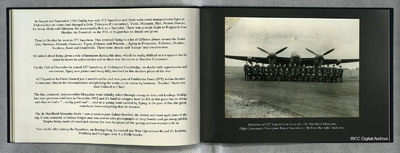Sam Saunders 627 Squadron
Title
Sam Saunders 627 Squadron
Description
After a spell with 512 squadron mostly transportation flights Sam returned to the UK, flying as an instructor.
A the end of 1943 he returned to Bomber Command, 627 Squadron.
There is a photograph of the squadron grouped in front of a Mosquito.
A the end of 1943 he returned to Bomber Command, 627 Squadron.
There is a photograph of the squadron grouped in front of a Mosquito.
Creator
Date
2013-10
Temporal Coverage
Spatial Coverage
Language
Format
One printed sheet and one b/w photograph
Publisher
Rights
This content is available under a CC BY-NC 4.0 International license (Creative Commons Attribution-NonCommercial 4.0). It has been published ‘as is’ and may contain inaccuracies or culturally inappropriate references that do not necessarily reflect the official policy or position of the University of Lincoln or the International Bomber Command Centre. For more information, visit https://creativecommons.org/licenses/by-nc/4.0/ and https://ibccdigitalarchive.lincoln.ac.uk/omeka/legal.
Contributor
Identifier
BThickettPSaundersEJv10014
Transcription
In August and September 1943 Daddy was with 512 Squadron and there were more transportation flights in Dakotas but the routes had changed a little, Telergma (Constantine), Tunis, Monastir, Sfax, Maison Blanche, La Senia, Blida and Gibraltar. He occasionally flew as a 2nd pilot. There was a single flight to Reykjavik from Hendon via Prestwick on the 27th of August but no details are given.
Then in October he went to 271 Squadron. This involved flying in a lot of different planes around the British Isles; Harrows, Oxfords, Dominies, Tigers, Dakotas and Proctors...flying to Doncaster, Tollerton, Dunfries, Renfrew, Errol and Donibristle. There were circuits and 'bumps' and weather tests.
He talked about being given a role of instructor during this time, which he really disliked and it appears that he asked to return to active service and so there was the move to Bomber Command.
On the 12th of December he joined 627 Squadron, Oakington Cambridge, no doubt with apprehension and excitement, flying new planes and being fully involved in this decisive phase of the war.
627 Squadron had been formed just a month earlier and was part of Pathfinder Force (PFF) within Bomber Command, famous for reconnaissance and plotting the routes to be taken by bombers. 'Bomber' Harris was their Colonel in Chief.
The fast, unarmed manoeuvrable Mosquitos were initially taken through many air tests and landings. Daddy's last war operation had been in December 1942 and it's hard to imagine how he felt at this point but he always said that he had a”...really good war”...and as a young man excited by flying, to be part of this elite group must have been everything that he wanted.
The de [sic] Havilland Mosquito Mark 1 was a twin-engine fighter-bomber, the fastest and most agile plane in the sky. It was unarmed, to reduce weight and was sent to take photographs or drop bombs and get away quickly. Despite being make of wood and canvas this was the plane all the young airmen wanted to be in.
Two weeks after joining the Squadron, on Boxing Day he carried out War Operations 46 and 47, bombing Duisberg and Cologne with 4 x 500lb bombs.
[page break]
[black and white photograph]
Members of 627 Squadron in front of a De Havilland Mosquito. Flight Lieutenant Navigator Ernest Saunders is 7th from the right, back row.
Then in October he went to 271 Squadron. This involved flying in a lot of different planes around the British Isles; Harrows, Oxfords, Dominies, Tigers, Dakotas and Proctors...flying to Doncaster, Tollerton, Dunfries, Renfrew, Errol and Donibristle. There were circuits and 'bumps' and weather tests.
He talked about being given a role of instructor during this time, which he really disliked and it appears that he asked to return to active service and so there was the move to Bomber Command.
On the 12th of December he joined 627 Squadron, Oakington Cambridge, no doubt with apprehension and excitement, flying new planes and being fully involved in this decisive phase of the war.
627 Squadron had been formed just a month earlier and was part of Pathfinder Force (PFF) within Bomber Command, famous for reconnaissance and plotting the routes to be taken by bombers. 'Bomber' Harris was their Colonel in Chief.
The fast, unarmed manoeuvrable Mosquitos were initially taken through many air tests and landings. Daddy's last war operation had been in December 1942 and it's hard to imagine how he felt at this point but he always said that he had a”...really good war”...and as a young man excited by flying, to be part of this elite group must have been everything that he wanted.
The de [sic] Havilland Mosquito Mark 1 was a twin-engine fighter-bomber, the fastest and most agile plane in the sky. It was unarmed, to reduce weight and was sent to take photographs or drop bombs and get away quickly. Despite being make of wood and canvas this was the plane all the young airmen wanted to be in.
Two weeks after joining the Squadron, on Boxing Day he carried out War Operations 46 and 47, bombing Duisberg and Cologne with 4 x 500lb bombs.
[page break]
[black and white photograph]
Members of 627 Squadron in front of a De Havilland Mosquito. Flight Lieutenant Navigator Ernest Saunders is 7th from the right, back row.
Collection
Citation
Penny Thickett, “Sam Saunders 627 Squadron,” IBCC Digital Archive, accessed July 27, 2024, https://ibccdigitalarchive.lincoln.ac.uk/omeka/collections/document/25334.
Item Relations
This item has no relations.

